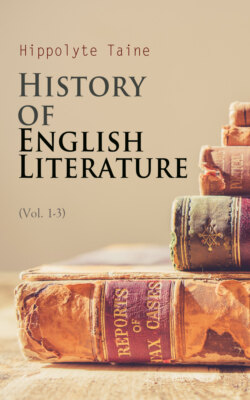Читать книгу History of English Literature (Vol. 1-3) - Taine Hippolyte - Страница 31
На сайте Литреса книга снята с продажи.
SECTION II.—The Decline of the Middle Ages
ОглавлениеTable of Contents
Two notions raised the Middle Ages above the chaos of barbarism: one religious, which had fashioned the gigantic cathedrals, and swept the masses from their native soil to hurl them upon the Holy Land; the other secular, which had built feudal fortresses, and set the man of courage erect and armed, within his own domain: the one had produced the adventurous hero, the other the mystical monk; the one, to wit, the belief in God, the other the belief in self. Both, running to excess, had degenerated by the violence of their own strength: the one had exalted independence into rebellion, the other had turned piety into enthusiasm: the first made man unfit for civil life, the second drew him back from natural life: the one, sanctioning disorder, dissolved society; the other, enthroning infatuation, perverted intelligence. Chivalry had need to be repressed because it issued in brigandage; devotion restrained because it induced slavery. Turbulent feudalism grew feeble, like oppressive theocracy; and the two great master passions, deprived of their sap and lopped of their stem, gave place by their weakness to the monotony of habit and the taste for worldliness, which shot forth in their stead and flourished under their name.
Gradually, the serious element declined, in books as in manners, in works of art as in books. Architecture, instead of being the handmaid of faith, became the slave of fantasy. It was exaggerated, became too ornamental, sacrificing general effect to detail, shot up its steeples to unreasonable heights, decorated its churches with canopies, pinnacles, trefoiled gables, open-work galleries. "Its whole aim was continually to climb higher, to clothe the sacred edifice with a gaudy bedizenment, as if it were a bride on her wedding morning."[194] Before this marvellous lacework, what emotion could one feel but a pleased astonishment? What becomes of Christian sentiment before such scenic ornamentations? In like manner literature sets itself to play. In the eighteenth century, the second age of absolute monarchy, we saw on one side finials and floriated cupolas, on the other pretty vers de societé, courtly and sprightly tales, taking the place of severe beauty-lines and noble writings. Even so in the fourteenth century, the second age of feudalism, they had on one side the stone fretwork and slender efflorescence of aërial forms, and on the other finical verses and diverting stories, taking the place of the old grand architecture and the old simple literature. It is no longer the overflowing of a true sentiment which produces them, but the craving for excitement. Consider Chaucer, his subjects, and how he selects them. He goes far and wide to discover them, to Italy, France, to the popular legends, the ancient classics. His readers need diversity, and his business is to "provide fine tales": it was in those days the poet's business.[195] The lords at table have finished dinner, the minstrels come and sing, the brightness of the torches falls on the velvet and ermine, on the fantastic figures, the motley, the elaborate embroidery of their long garments; then the poet arrives, presents his manuscript, "richly illuminated, bound in crimson velvet, embellished with silver clasps and bosses, roses of gold": they ask him what his subject is, and he answers "Love."
